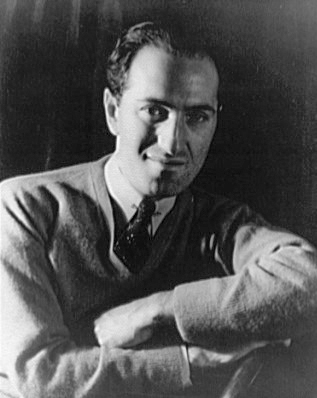George Gershwin
(1898-1937)
 George Gershwin is often closely associated with the “Roaring 20s” and the “Jazz Age.” His music, specifically Rhapsody in Blue (1924), swung open the door for a new American music era by combining classical traditions with jazz idioms to create some of the most iconic works of the 20th century.
George Gershwin is often closely associated with the “Roaring 20s” and the “Jazz Age.” His music, specifically Rhapsody in Blue (1924), swung open the door for a new American music era by combining classical traditions with jazz idioms to create some of the most iconic works of the 20th century.
Gershwin was born in Brooklyn, New York, on September 26, 1898. His parents had immigrated from Russia earlier that decade. He was the second of four children, only two years younger than his brother Ira. While Gershwin did not thrive academically, he was very musically inclined. His family was happy to find he had taught himself piano. He dropped out of high school in 1914 to become a “song plugger” for Tin Pan Alley, a collection of publishers that released sheet music for the most popular songs of the day. For five years, Gershwin trusted his ambition, hard work, and musical talent until he rose to fame with his 1919 song “Swanee,” lyrics by Irving Caesar. While working with Caesar, Gershwin also completed his first Broadway musical, La La Lucille.
In 1924, George joined creative forces with his brother, Ira, to begin composing and writing popular music for Broadway. George wrote the music and Ira was the lyricist. For 13 roaring years, the team of brothers took Broadway and Hollywood by storm. Together they wrote a string of successful musicals, including Of Thee I Sing (1931), the first musical comedy to win a Pulitzer Prize.
While the duo did a two-step down Broadway, Gershwin focused on establishing himself as a serious composer of concert and orchestral music. Paul Whiteman commissioned him to write a work for a “modern music” concert in February of 1924. Gershwin almost ran out of time composing Rhapsody in Blue, but it was a huge hit. The iconic opening is still familiar to almost every American today. The news of this success led to Walter Damrosch asking Gershwin in 1925 to compose a piano concerto for the New York Symphony Society. Concerto in F became Gershwin’s second orchestral masterpiece, even though, at the time, critics were weary of his music.
In 1926, Gershwin traveled to Paris to find a teacher and was attracted to the music of Ravel. However, after auditioning, Ravel refused to teach him, supposedly saying, “Why become a second-rate Ravel when you’re already a first-rate Gershwin?” Ravel referred Gershwin to Nadia Boulanger, a famous music theory and composition pedagogue who taught almost all the leading composers of the 20th century. She also refused to accept Gershwin as a student, claiming she did not want to ruin his jazz-influenced style with rigorous classical composition training. Nonetheless, after Gershwin visited Paris and absorbed the ambition and wonderment of the French city, the idea for a tone poem blossomed. An American in Paris was born. He brought home the iconic taxi horns used in the piece, which premiered in 1928.
His ambition was not satiated, and his most daring composition began taking shape. Porgy and Bess, a folk opera, premiered in 1935. It features songs such as “It Ain’t Necessarily So”, “I Loves You, Porgy”, and “Summertime”.
Gershwin’s musical influences can be traced to early in his career when he absorbed the jazz idioms of Tin Pan Alley. Some influences were more traditional, such as Beethoven, Bach, Debussy, and Wagner, however, his musical style was most impacted by modern composers and contemporaries, such as Ravel, Berg, Schoenberg, Shostakovich, Stravinsky, and Milhaud.
After successfully completing many Broadway productions and establishing themselves as prominent musical figures, the Gershwin brothers moved to Los Angeles. Together, they completed numerous Hollywood musical comedy films, such as Shall We Dance and Damsel in Distress, starring Fred Astaire.
While working on the music for The Goldwyn Follies, at age 39, George Gershwin died of a brain tumor on July 11, 1937.
Click below to view George Gershin titles:
Click Here to see other Featured Composers
t7t3l0uhl8|0010C39D6D07|DetailContent|contenttext|F7919E8D-3BBA-44B1-83B5-9380E5A18134
<